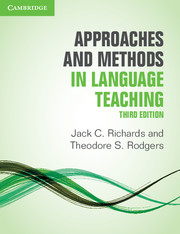Book contents
- Frontmatter
- Contents
- Acknowledgments
- Introduction to the third edition
- I Major trends in twentieth-century language teaching
- II Current approaches and methods
- III Alternative twentieth-century approaches and methods
- IV The teaching and learning environment
- Appendix: Comparison of approaches and methods
- Author index
- Subject index
3 - The Oral Approach and Situational Language Teaching
Published online by Cambridge University Press: 08 April 2022
- Frontmatter
- Contents
- Acknowledgments
- Introduction to the third edition
- I Major trends in twentieth-century language teaching
- II Current approaches and methods
- III Alternative twentieth-century approaches and methods
- IV The teaching and learning environment
- Appendix: Comparison of approaches and methods
- Author index
- Subject index
Summary
Few language teachers today are familiar with the terms Oral Approach or Situational Language Teaching, which both refer to an approach to language teaching developed by British applied linguists, the first dating from the 1920s and 1930s and the second from the 1950s and 1960s. Even though neither term is commonly used today, the impact of the Oral Approach has been long-lasting, and it shaped the design of many widely used English as a Second/Foreign Language (ESL/EFL) textbooks and courses, particularly those published in the United Kingdom. Situational Language Teaching, a type of oral approach, continued to be popular well into the 1980s, and some of these textbooks are still used today. One of the most successful ESL courses published, Streamline English (Hartley and Viney 1978), reflected the classic principles of Situational Language Teaching, as did many other series that have been widely used, such as Access to English (Coles and Lord 1975), Kernel Lessons Plus (O’Neill 1973) and many of L. G. Alexander's widely used textbooks, for example, New Concept English (1967). Perhaps the biggest legacy of the Oral Approach was the PPP lesson format: Presentation-Practice-Production, which will be discussed further below. Hundreds of thousands of teachers worldwide have been trained to use this lesson for-mat, and it continues to be seen in language textbooks today. This chapter will explore the development of the Oral Approach in Britain. In the next chapter, we will look at related developments in the United States.
Introduction
The origins of this approach began with the work of British applied linguists in the 1920s and 1930s. Beginning at this time, a number of outstanding applied linguists developed the basis for a principled approach to methodology in language teaching. Two of the lead-ers in this movement were Harold Palmer (1877–1949) and A. S. Hornby (1898–1978), two of the most prominent figures in British twentieth-century language teaching. Both were familiar with the work of such prominent linguists of the time as the Danish grammarian Otto Jespersen and the phonetician Daniel Jones, as well as with the Direct Method. They attempted to develop a more scientific foundation for an oral approach to teaching English than was evidenced in the Direct Method. The result was a systematic study of the princi-ples and procedures that could be applied to the selection and organization of the content of a language course (Palmer 1917, 1921).
Information
- Type
- Chapter
- Information
- Approaches and Methods in Language Teaching , pp. 44 - 57Publisher: Cambridge University PressPrint publication year: 2014
